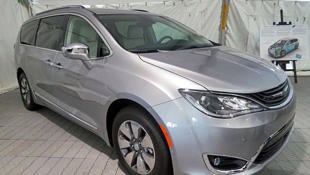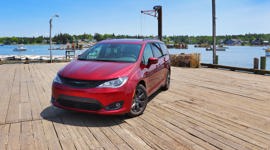CHELSEA, Michigan – In 1983, Chrysler kick-started a brand-new segment when the first Dodge Caravan rolled off the production line. Inventing the minivan was a stroke of brilliance – not only fulfilling family transportation requirements with a vehicle expressly built for their needs, but almost certainly rescuing Chrysler from impending financial extinction.
Fiat-Chrysler introduces another milestone: their first mass-produced hybrid vehicle, and the North American market's very first hybrid minivan.
The rest is history. Chrysler went on to dominate the segment they spearheaded with innovations like sliding doors and Stow ’n’ Go seat storage – and the ease with which its front-wheel-drive, car-based platform won over the driving public helped pave the way for future crossover development.
Debuting early this year as a 2017, the Pacifica resurrects a badge previously used on one of the company's older crossovers, and replaces the venerable Town & Country.
And now, Fiat-Chrysler introduces another milestone: their first mass-produced hybrid vehicle, and the North American market's very first hybrid minivan.
And thanks to an $85.8 million investment from the province's Jobs and Prosperity Fund, when the Pacifica Hybrid begins production later this year, it will be built in Windsor, Ontario.
This isn't FCA's first kick at the PHEV cat – they'd produced a limited number of hybrid vans and trucks in partnership with Daimler, BMW and General Motors and an electrified version of the popular Fiat 500, available only in California.
We got a sneak-peak at the newest Pacifica at Chrysler's Proving Grounds in Chelsea, Michigan, but unfortunately we weren't able to drive it – yet.
Aside from the charge port on the front left fender, differentiating the Pacifica Hybrid from the conventional model are its unique Teal Pearl paint and interior colours and hybrid specific grill and aerodynamic wheel designs. Curiously, there's no mention of the vehicle's plug-in capability, it's badged merely "hybrid".
Using a system of two electric motors and lithium battery storage pack with a conventional gasoline engine for backup, the Pacifica Hybrid has a combined range of over 850 km. But it's capable of travelling 48 km purely on electric power.
The 16 kW lithium-ion battery cells, modules and packs are manufactured by LG Chem in Holland, Michigan.
In case you missed it: 2017 Chrysler Pacifica, Everything you need to know
"One of the key things we're working on with LG Chem is our battery," said John Gibson, Chief Engineer for Chrysler's Electrified Powertrain Programs.
"We've designed our own internal transmission at FCA that will allow us to do 48 km of all-electric drive. Then, when we run out of battery, we transition to hybrid mode and the engine will come on and sustain and we'll get another 805 km of range with the gas engine."
The battery pack is located beneath the second row of seats, since maintaining cargo capacity was as important as fuel efficiency. Unfortunately, this means that this Pacifica won't be able to offer Chrysler's famous "Stow ’n’ Go" tumble-into-the-floor seat system that provides owners with a perfectly flat load floor. Instead, the hybrid Pacifica features removable second row seats.
The Pacifica Hybrid is powered by a 248 hp 3.6L V6, combined with the electric drive system and paired with a single-input electrically variable transmission (SIEVT) in place of the nine-speed automatic found in the regular vehicle. The new engine is a Pentastar that's been converted to the Atkinson cycle, with a higher compression ratio and longer intake valve operation for increased combustion efficiency.
This type of engine's inherent lack of low-end power is offset by the electric motors.
Total power of the combined hybrid powertrain is an estimated 260 hp.
"We designed and developed in-house the electrically variable transmission. One of the unique, innovative things that we did is, typically in these type of transmissions, only one of the electric motors [is connected], and in this one we have two.
“Typically, one of those motors is used as a generator, and it charges the battery or starts the engine. The other motor is the main traction motor. One of our innovations is that we implemented a one-way clutch in there that allows us in electric drive to actually use both electric motors to drive the vehicle. So that gives us a bit of advantage," said Gibson.
That clutch is the key to the PHEV's performance, enabling both motors to work together – providing enough torque to the wheels that the Pacifica Hybrid can accelerate up to 120 km/h in all-electric drive. One motor helps balance the gasoline engine and keep it at optimum range in parallel to the other, which normally helps start the engine and acts as a generator.
During all-electric operation, they're decoupled from the engine and work together to supply all the power to the wheels.
The Pacifica's lightweight platform was an advantage when it came to its hybridization. While the battery pack is a hefty 168 kg, the base Pacifica is nearly 113 kg lighter than its FCA predecessor.
Recharging takes about two hours using the 240 volt home charging station, and approximately three times longer when plugged into a standard household outlet.
The Pacifica Hybrid is scheduled to begin production in Windsor later this year. Pricing won't be announced until closer to production date.




















